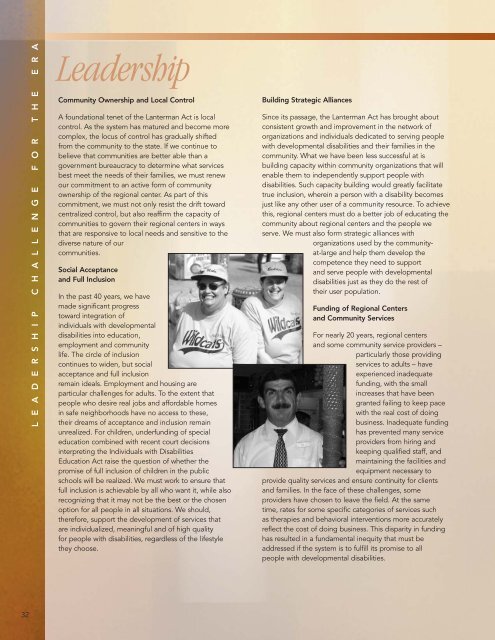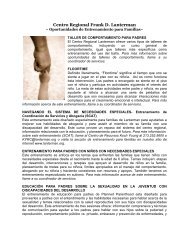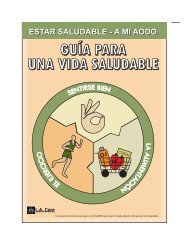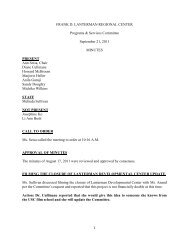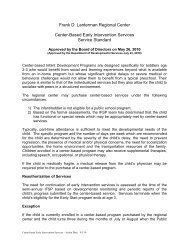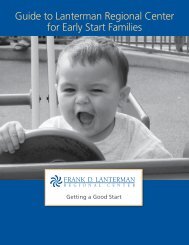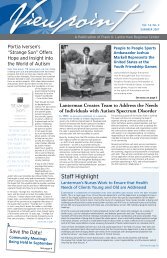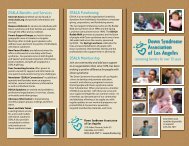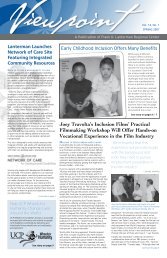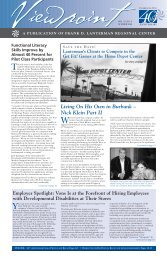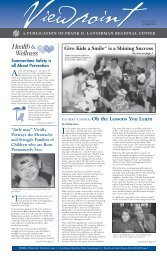40th History Brochure-r2 - Frank D. Lanterman Regional Center
40th History Brochure-r2 - Frank D. Lanterman Regional Center
40th History Brochure-r2 - Frank D. Lanterman Regional Center
Create successful ePaper yourself
Turn your PDF publications into a flip-book with our unique Google optimized e-Paper software.
L E A D E R S H I P C H A L L E N G E F O R T H E E R ALeadershipCommunity Ownership and Local ControlA foundational tenet of the <strong>Lanterman</strong> Act is localcontrol. As the system has matured and become morecomplex, the locus of control has gradually shiftedfrom the community to the state. If we continue tobelieve that communities are better able than agovernment bureaucracy to determine what servicesbest meet the needs of their families, we must renewour commitment to an active form of communityownership of the regional center. As part of thiscommitment, we must not only resist the drift towardcentralized control, but also reaffirm the capacity ofcommunities to govern their regional centers in waysthat are responsive to local needs and sensitive to thediverse nature of ourcommunities.Social Acceptanceand Full InclusionIn the past 40 years, we havemade significant progresstoward integration ofindividuals with developmentaldisabilities into education,employment and communitylife. The circle of inclusioncontinues to widen, but socialacceptance and full inclusionremain ideals. Employment and housing areparticular challenges for adults. To the extent thatpeople who desire real jobs and affordable homesin safe neighborhoods have no access to these,their dreams of acceptance and inclusion remainunrealized. For children, underfunding of specialeducation combined with recent court decisionsinterpreting the Individuals with DisabilitiesEducation Act raise the question of whether thepromise of full inclusion of children in the publicschools will be realized. We must work to ensure thatfull inclusion is achievable by all who want it, while alsorecognizing that it may not be the best or the chosenoption for all people in all situations. We should,therefore, support the development of services thatare individualized, meaningful and of high qualityfor people with disabilities, regardless of the lifestylethey choose.Building Strategic AlliancesSince its passage, the <strong>Lanterman</strong> Act has brought aboutconsistent growth and improvement in the network oforganizations and individuals dedicated to serving peoplewith developmental disabilities and their families in thecommunity. What we have been less successful at isbuilding capacity within community organizations that willenable them to independently support people withdisabilities. Such capacity building would greatly facilitatetrue inclusion, wherein a person with a disability becomesjust like any other user of a community resource. To achievethis, regional centers must do a better job of educating thecommunity about regional centers and the people weserve. We must also form strategic alliances withorganizations used by the communityat-largeand help them develop thecompetence they need to supportand serve people with developmentaldisabilities just as they do the rest oftheir user population.Funding of <strong>Regional</strong> <strong>Center</strong>sand Community ServicesFor nearly 20 years, regional centersand some community service providers –particularly those providingservices to adults – haveexperienced inadequatefunding, with the smallincreases that have beengranted failing to keep pacewith the real cost of doingbusiness. Inadequate fundinghas prevented many serviceproviders from hiring andkeeping qualified staff, andmaintaining the facilities andequipment necessary toprovide quality services and ensure continuity for clientsand families. In the face of these challenges, someproviders have chosen to leave the field. At the sametime, rates for some specific categories of services suchas therapies and behavioral interventions more accuratelyreflect the cost of doing business. This disparity in fundinghas resulted in a fundamental inequity that must beaddressed if the system is to fulfill its promise to allpeople with developmental disabilities.32


